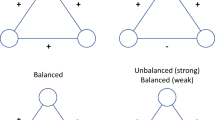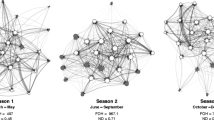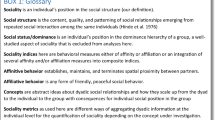Abstract
Social organization is often studied through point estimates of individual association or interaction patterns, which does not account for temporal changes in the course of familiarization processes and the establishment of social dominance. Here, we present new insights on short-term temporal dynamics in social organization of mixed-sex groups that have the potential to affect sexual selection patterns. Using the live-bearing Atlantic molly (Poecilia mexicana), a species with pronounced male size polymorphism, we investigated social network dynamics of mixed sex experimental groups consisting of eight females and three different-sized males over a period of 5 days. Analyzing association-based social networks as well as direct measures of spatial proximity, we found that large males tended to monopolize most females, while excluding small- and medium-bodied males from access to females. This effect, however, emerged only gradually over time, and different-sized males had equal access to females on day 1 as well as day 2, though to a lesser extent. In this highly aggressive species with strong social dominance stratifications, the observed temporal dynamics in male-female association patterns may balance the presumed reproductive skew among differentially competitive male phenotypes when social structures are unstable (i.e., when individual turnover rates are moderate to high). Ultimately, our results point toward context-dependent sexual selection arising from temporal shifts in social organization.



Similar content being viewed by others
References
Bateman AJ (1948) Intra-sexual selection in Drosophila. Heredity 2:349–368
Beaugrand J, Goulet C, Payette D (1991) Outcome of dyadic conflict in male green swordtail fish, Xiphophorus helleri: effects of body size and prior dominance. Anim Behav 41:417–424
Becher SA, Magurran AE (2004) Multiple mating and reproductive skew in Trinidadian guppies. Proc R Soc Lond B 271:1009–1014
Berglund A, Bisazza A, Pilastro A (1996) Armaments and ornaments: an evolutionary explanation of traits of dual utility. Biol J Linn Soc 58:385–399
Bierbach D, Klein M, Sassmannshausen V, Schlupp I, Riesch R, Parzefall J, Plath M (2012) Divergent evolution of male aggressive behaviour: another reproductive isolation mechanism in extremophile poeciliid fishes. Intern J Evol Biol 2012:148745
Bierbach D, Makowicz AM, Schlupp I, Geupel H, Streit B, Plath M (2013) Casanovas are liars: behavioral syndromes, sperm competition risk, and the evolution of deceptive male mating behavior in live-bearing fishes [v3, indexed]. F1000Research 2:75
Bierbach D, Schulte M, Herrmann N, Tobler M, Stadler S et al (2011a) Predator-induced changes of female mating preferences: innate and experiential effects. BMC Evol Biol 11:190
Bierbach D, Girndt A, Hamfler S, Klein M, Müksch F et al (2011b) Male fish use prior knowledge about rivals to adjust their mate choice. Biol Lett 7:349–351
Bisazza A, Vaccari G, Pilastro A (2001) Female mate choice in a mating system dominated by male sexual coercion. Behav Ecol 12:59–64
Bisazza A (1993) Male competition, female mate choice and sexual size dimorphism in poeciliid fishes. Mar Behav Physiol 23:257–286
Borowsky RL (1987) Genetic polymorphism in adult male size in Xiphophorus variatus (Atheriniformes: Poeciliidae). Copeia 1987:782–787
Brown C (2001) Familiarity with the test environment improves escape responses in the crimson spotted rainbowfish, Melanotaenia duboulayi. Anim Cogn 4:109–113
Cade WH (1981) Alternative male strategies: genetic differences in crickets. Science 212:563–564
Connell JH (1978) Diversity in tropical rain forests and coral reefs. Science 199:1302–1310
Cornwallis CK, Uller T (2010) Towards an evolutionary ecology of sexual traits. Trends Ecol Evol 25:145–152
Croft DP, Arrowsmith BJ, Bielby J, Skinner K, White E, Couzin ID, Magurran AE, Ramnarine I, Krause J (2003) Mechanisms underlying shoal composition in the Trinidadian guppy, Poecilia reticulata. Oikos 100:429–438
Croft DP, James R, Krause J (2008) Exploring animal social networks. Princeton University Press, Princeton
Croft DP, James R, Ward AJW, Botham MS, Mawdsley D, Krause J (2005) Assortative interactions and social networks in fish. Oecologia 143:211–219
Croft DP, Madden JR, Franks DW, James R (2011) Hypothesis testing in animal social networks. Trends Ecol Evol 26:502–507
Darden SK, James R, Ramnarine IW, Croft DP (2009) Social implications of the battle of the sexes: sexual harassment disrupts female sociality and social recognition. Proc R Soc Lond B276:2651–2656
Dominey WJ (1980) Female mimicry in male bluegill sunfish—a genetic polymorphism? Nature 284:546–548
Dugatkin LA, Dugatkin AD (2007) Extrinsic effects, estimating opponents' RHP, and the structure of dominance hierarchies. Biol Lett 3:614–616
Dormann FC, McPherson JM, Araújo MB, Bivand R, Bolliger J et al (2007) Methods to account for spatial autocorrelation in the analysis of species distributional data: a review. Ecography 30:609–628
Erbelding-Denk C, Schröder J, Schartl M, Nanda I, Schmid M, Epplen J (1994) Male polymorphism in Limia perugiae (Pisces: Poeciliidae). Behav Genet 24:95–101
Girndt A, Riesch R, Schröder C, Schlupp I, Plath M (2012) Multiple paternity in different populations of the sailfin molly (Poecilia latipinna). Anim Biol 62:245–262
Gowaty PA, Kim Y-K, Anderson WW (2012) No evidence of sexual selection in a repetition of Bateman’s classic study of Drosophila melanogaster. P Natl Acad Sci USA 109:11740–11745
Griffiths SW, Magurran AE (1997) Familiarity in schooling fish: how long does it take to acquire? Anim Behav 53:945–949
Gross MR (1985) Disruptive selection for alternative life histories in salmon. Nature 313:47–48
Gross MR (1996) Alternative reproductive strategies and tactics: diversity within sexes. Trends Ecol Evol 11:92–98
Hunt J, Breuker CJ, Sadowski JA, Moore AJ (2009) Male–male competition, female mate choice and their interaction: determining total sexual selection. J Evol Biol 22:13–26
Jennions M, Petrie M (1997) Variation in mate choice and mating preferences: a review of causes and consequences. Biol Rev 72:283–327
Kallman KD (1989) Genetic control of size at maturity in Xiphophorus. In: Snelson GK (ed) Ecology and evolution in livebearing fishes (Poeciliidae). Prentice-Hall, Englewood Cliffs, pp 163–184
Kelley JL, Graves JA, Magurran AE (1999) Familiarity breeds contempt in guppies. Nature 401:661–662
Kelley JL, Morrell LJ, Inskip C, Krause J, Croft DP (2011) Predation risk shapes social networks in fission-fusion populations. PLoS ONE 6:e24280
Kodric-Brown A (1986) Satellites and sneakers: opportunistic male breeding tactics in pupfish (Cyprinodon pecosensis). Behav Ecol Sociobiol 19:425–432
Köhler A, Hildenbrand P, Schleucher E, Riesch R, Arias-Rodriguez L, Streit B, Plath M (2011) Effects of male sexual harassment on female time budgets, feeding behavior, and metabolic rates in a tropical livebearing fish (Poecilia mexicana). Behav Ecol Sociobiol 65:1513–1523
Krause J, Croft DP, James R (2007) Social network theory in the behavioural sciences: potential applications. Behav Ecol Sociobiol 62:15–27
Lampert KP, Schmidt C, Fischer P, Volff J-N, Hoffmann C, Muck J, Lohse MJ, Ryan MJ, Schartl M (2010) Determination of onset of sexual maturation and mating behavior by melanocortin receptor 4 polymorphisms. Curr Biol 20:1729–1734
Lusseau D, Whitehead H, Gero S (2008) Incorporating uncertainty into the study of animal social networks. Anim Behav 75:1809–1815
Magellan K, Magurran AE (2007) Behavioural profiles: individual consistency in male mating behaviour under varying sex ratios. Anim Behav 74:1545–1550
Makowicz AM, Schlupp I (2013) The direct costs of living in a sexually harassing environment. Anim Behav 85:569–577
Maynard-Smith J (1982) Evolution and the theory of games. Cambridge University Press, Cambridge
McDonald GC, James R, Krause J, Pizzari T (2013) Sexual networks: measuring sexual selection in structured, polyandrous populations. Philos T Roy Soc B 368:20120356
Miller RR (2006) Freshwater fishes of Mexico. Chicago University Press, Chicago
Morrell LJ, Croft DP, Dyer JRG, Chapman BB, Kelley JL, Laland KN, Krause J (2008) Association patterns and foraging behaviour in natural and artificial guppy shoals. Anim Behav 76:855–864
Morris MR, Batra P, Ryan MJ (1992) Male-male competition and access to females in the swordtail Xiphophorus nigrensis. Copeia 1992:980–986
Morris MR, Ryan MJ (1992) Breeding cycles in natural populations of Xiphophorus nigrensis, X. multilineatus, and X. pygmaeus. Copeia 1992:1074–1077
Newman MEJ (2004) Analysis of weighted networks. Phys Rev E 70:056131
Niemeitz A, Kreutzfeldt R, Schartl M, Parzefall J, Schlupp I (2002) Male mating behaviour of a molly, Poecilia latipunctata: a third host for the sperm-dependent Amazon molly, Poecilia formosa. Acta Ethol 5:45–49
Parker GA (1974) Assessment strategy and the evolution of fighting behaviour. J Theor Biol 47:223–243
Parzefall J (1969) Zur vergleichenden Ethologie verschiedener Mollienesia-Arten einschließlich einer Höhlenform von Mollienesia sphenops. Behaviour 33:1–38
Parzefall J (1979) Zur Genetik und biologischen Bedeutung des Aggressionsverhaltens von Poecilia sphenops (Pisces, Poeciliidae). Z Tierpsychol 50:399–422
Plath M (2008) Male mating behavior and costs of sexual harassment for females in cavernicolous and extremophile populations of Atlantic mollies (Poecilia mexicana). Behaviour 145:73–98
Plath M, Hermann B, Schroder C, Riesch R, Tobler M, Garcia de Leon F, Schlupp I, Tiedemann R (2010) Locally adapted fish populations maintain small-scale genetic differentiation despite perturbation by a catastrophic flood event. BMC Evol Biol 10:256
Plath M, Parzefall J, Korner K, Schlupp I (2004) Sexual selection in darkness? Female mating preferences in surface- and cave-dwelling Atlantic mollies, Poecilia mexicana (Poeciliidae, Teleostei). Behav Ecol Sociobiol 55:596–601
Plath M, Parzefall J, Schlupp I (2003) The role of sexual harassment in cave and surface dwelling populations of the Atlantic molly, Poecilia mexicana (Poeciliidae, Teleostei). Behav Ecol Sociobiol 54:303–309
Plath M, Tobler M (2010) Subterranean fishes of Mexico (Poecilia mexicana, Poeciliidae). In: Trajano E, Bichuette ME, Kapoor BG (eds) The biology of subterranean fishes. Science Publishers, Enfield, pp 283–332
Pocklington R, Dill L (1995) Predation on females or males: who pays for bright male traits. Anim Behav 49:1122–1124
Qvarnström A (2001) Context-dependent genetic benefits from mate choice. Trends Ecol Evol 16:5–7
Qvarnström A, Forsgren E (1998) Should females prefer dominant males? Trends Ecol Evol 13:498–501
Reynolds JD, Gross MD, Coombs MJ (1993) Environmental conditions and male morphology determine alternative mating behaviour in Trinidadian guppies. Anim Behav 45:145–152
Riesch R, Plath M, Schlupp I (2011) Toxic hydrogen sulphide and dark caves: pronounced male life-history divergence among locally adapted Poecilia mexicana (Poeciliidae). J Evol Biol 24:596–606
Ryan MJ, Pease CM, Morris MR (1992) A genetic polymorphism in the swordtail Xiphophorus nigrensis: testing the prediction of equal fitnesses. Am Nat 139:21–31
Schartl M, Erbelding-Denk C, Hölter S, Nanda I, Schmid M, Schröder JH, Epplen JT (1993) Reproductive failure of dominant males in the poeciliid fish Limia perugiae determined by DNA fingerprinting. P Natl Acad Sci USA 90:7064–7068
Sefc KM, Hermann CM, Koblmüller S (2009) Mating system variability in a mouthbrooding cichlid fish from a tropical lake. Mol Ecol 18:3508–3517
Sih A, Hanser S, McHugh K (2009) Social network theory: new insights and issues for behavioral ecologists. Behav Ecol Sociobiol 63:975–988
Sinervo B, Lively CM (1996) The rock-paper-scissors game and the evolution of alternative male strategies. Nature 380:240–243
Taborsky M, Brockmann HJ (2010) Alternative reproductive tactics and life history phenotypes. In: Kappeler P (ed) Animal behaviour: evolution and mechanisms. Springer, Heidelberg, pp 537–586
Tatarenkov A, Healey CIM, Grether GF, Avise JC (2008) Pronounced reproductive skew in a natural population of green swordtails, Xiphophorus helleri. Mol Ecol 17:4522–4534
Tobler M, Franssen CM, Plath M (2008) Male-biased predation of a cave fish by a giant water bug. Naturwissenschaften 95:775–779
Travis J, Woodward BD (1989) Social context and courtship flexibility in male sailfin mollies, Poecilia latipinna (Pisces: Poecillidae). Anim Behav 38:1001–1011
Trexler J, Tempe R, Travis J (1994) Size-selective predation of Sailfin mollies by two species of heron. Oikos 69:250–259
Trexler JC, Travis J, Trexler M (1990) Phenotypic plasticity in the Sailfin molly, Poecilia latipinna (Pisces: Poeciliidae). II. Laboratory experiment. Evolution 44:157–167
Walling C, Royle N, Lindström J, Metcalfe N (2010) Do female association preferences predict the likelihood of reproduction? Behav Ecol Sociobiol 64:541–548
Whitehead H (2008) Analyzing animal societies. University of Chicago Press, Chicago
Wilson ADM, Croft DP, Krause J (2013) Social networks in elasmobranchs and teleost fishes. Fish Fish. doi:10.1111/faf.12046
Witte K, Ryan MJ (2002) Mate choice copying in the sailfin molly, Poecilia latipinna, in the wild. Anim Behav 63:943–949
Wolf M, Weissing FJ (2010) An explanatory framework for adaptive personality differences. Phil Transact R Soc B: Biol Sci 365:1471–2970
Wong BBM, Candolin U (2005) How is female mate choice affected by male competition? Biol Rev 80:559–571
Zimmerer EJ, Kallman KD (1989) Genetic basis for alternative reproductive tactics in the pygmy swordtail, Xiphophorus nigrensis. Evolution 43:1298–1307
Acknowledgments
We like to thank J. Appel, J. Hanisch, and M. Grothe for their assistance in the laboratory. Financial support came from the Deutsche Forschungsgemeinschaft (DFG; PL 470/1-3) as well as from the Leibniz Competition (SAW-2013-IGB-2).
Ethical standards
The experiments reported here comply with the current laws of the United States of Mexico and were run under the federal permits from Mexican agencies SAGARPA/CONAPESCA (DGOPA.09004.041111.3088) and SEMARNAT/Directión General de Vida Silvestre (SGPA/DGVS/04315/1).
Author information
Authors and Affiliations
Corresponding author
Additional information
Communicated by J. Lindström
Electronic supplementary material
Below is the link to the electronic supplementary material.
ESM 1
(DOCX 26 kb)
Rights and permissions
About this article
Cite this article
Bierbach, D., Oster, S., Jourdan, J. et al. Social network analysis resolves temporal dynamics of male dominance relationships. Behav Ecol Sociobiol 68, 935–945 (2014). https://doi.org/10.1007/s00265-014-1706-y
Received:
Revised:
Accepted:
Published:
Issue Date:
DOI: https://doi.org/10.1007/s00265-014-1706-y




